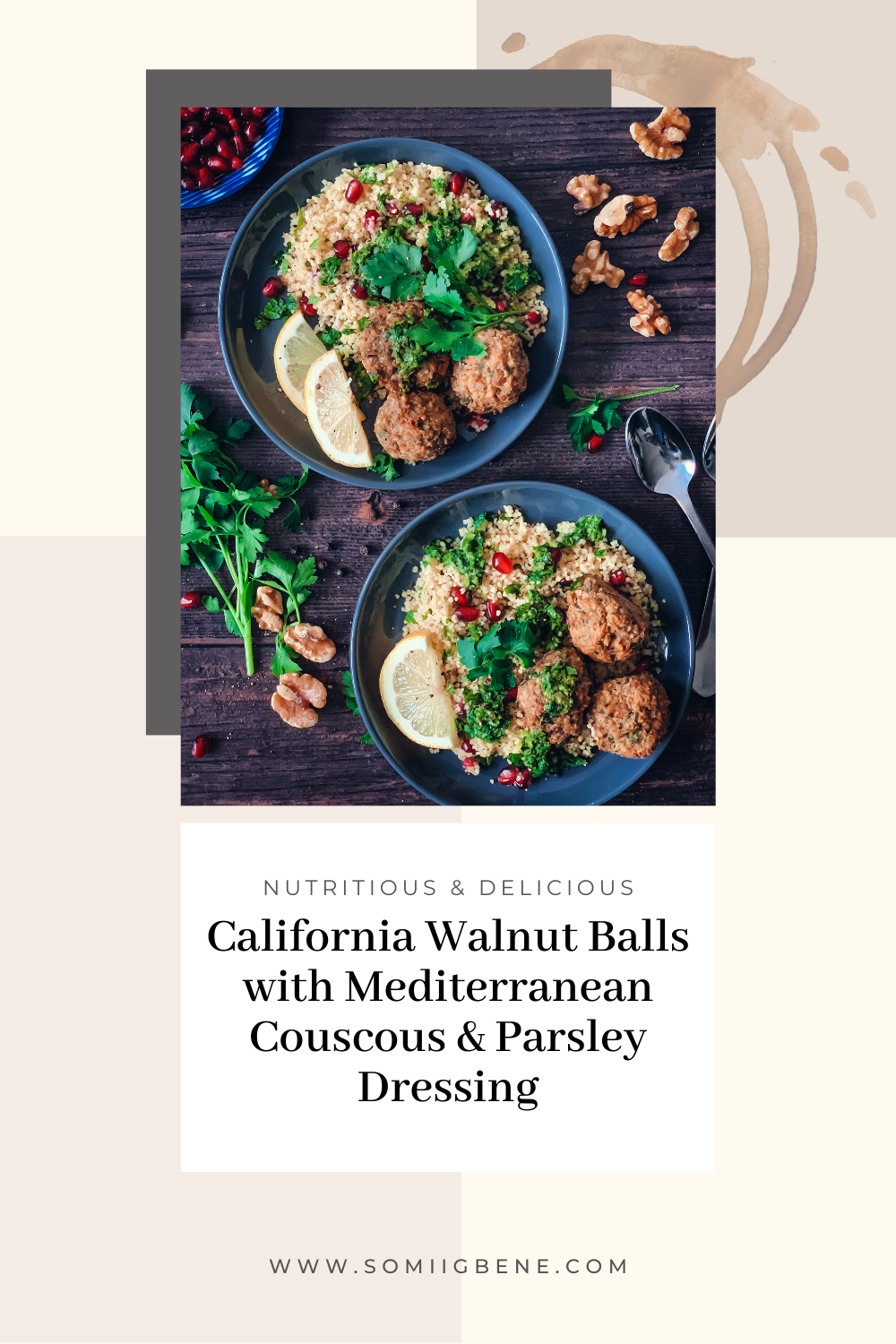
California Walnut ‘Meatballs’ with Mediterranean Couscous & Parsley Dressing
Want a meat and fish-free recipe that’s still bursting with healthy omega-3 fats and protein? Then bookmark this ‘meatballs’ recipe made with California Walnuts. They’re full of texture, nutritious and incredibly delicious!
Want to know the cuisine that’s scientifically proven to lower the risk of heart disease, type 2 diabetes and cancer?
I love that it’s naturally plant-based – it incorporates many fruits, vegetables, whole grains, nuts and seeds. And it uses herbs and spices that are rich in antioxidants and add decadent flavour to recipes.
Mediterranean cuisine promotes moderate amounts of fish, which are healthy sources of omega-3 fats and protein. But, fish can be a source of mercury, so it’s important to limit consumption to four times a week.
If you dislike fish or are thinking of adding more plant-based meals and snacks to your diet, you don’t need to worry about omega-3 fats. California Walnuts are a great source of them!
Walnuts are also a source of protein and have an advantage over fish by containing fibre. Fibre promotes digestive health and can help lower cholesterol levels to keep your heart healthy.
The Mediterranean cuisine uses very little red meat, which puts meat-containing recipes off the menu for the majority of the week. But this doesn’t mean you can’t enjoy recipes like lasagne, burgers or bolognese several times during the week.
The secret?
Make a plant-based alternative with California walnuts!

Walnuts have a unique taste and texture that allow you to crumble them and then combine them with other plant-based ingredients like mushrooms, beans, herbs and spices to make mince. You can use this California Walnut mince in lasagne, burgers, bolognese or for meatballs.
Genius, right?
My walnut ‘meatball’ recipe includes chickpeas, which boosts its protein content. It also contains Mediterranean herbs and spices like parsley, oregano, cinnamon, and cumin which add superb flavour.
I use an egg to bind the mixture. But, you can use a flax egg (1 tablespoon milled flaxseeds + 2.5 tablespoons water) or a plant-based egg-substitute to make the recipe vegan.
I enjoy my walnut ‘meatballs’ with couscous, but you can enjoy them with spaghetti, noodles, rice or any grain you fancy. You can stuff them in a baguette or burrito, or enjoy them alone as a tasty snack.
Print
California Walnut ‘Meatballs’ with Mediterranean Cous Cous
- Prep Time: 10
- Cook Time: 30
- Total Time: 40 mins
- Yield: Serves 4-6 1x
- Cuisine: Mediterranean
- Diet: Vegetarian
Description
A meat and fish-free recipe bursting with healthy omega-3 fats and protein.
Ingredients
For the walnut ‘no meatballs’ (Makes approximately 20 large balls)
- 105g California walnuts
- 240g cooked chickpeas
- 50g panko breadcrumbs or all-purpose flour
- 13g chopped fresh parsley
- 2 tablespoons olive oil
- 1 tablespoon ground cinnamon
- 1 tablespoon ground cumin
- 1 egg (or flax egg)
- 2 medium shallots, finely chopped
- 2 garlic cloves, finely chopped
- ½ teaspoon salt
For the couscous (serves 4)
- 200g couscous
- 2 tablespoons olive oil
- 3 tablespoons pomegranate seeds
- Fresh mint, large handful, finely chopped
- Salt to taste
For the parsley dressing
- 50g parsley, roughly chopped
- 4 tablespoons olive oil
- 1 large shallot, roughly chopped
- 1 fat garlic clove, roughly chopped
- 1 green chilli, sliced
- 3 tablespoons, lemon juice
- Salt, to taste
Instructions
California Walnut balls
Put all the ingredients for the meatballs into a food processor and pulse until the ingredients just combine. Don’t over-process or you’ll lose the texture of the walnuts.
Tip the mixture into a large bowl. Take around a tablespoon of the mix and roll between the palm of your hands to form a ball. If the mixture is too wet, add more breadcrumbs or flour. You should get approximately 20 large balls.
Refrigerate the balls for at least 30 minutes.
Heat the oven to 220C. Line a baking tray with parchment paper then arrange the balls on the tray and bake in the oven for 25 minutes or until golden brown. Turn the balls halfway through cooking. Set aside and keep warm.
Couscous
Put dry couscous in a large dish or bowl. Add olive oil and salt and mix well to combine. Add boiling water just to cover the top of the couscous. Cover with cling film and allow to rest for 10 minutes.
Add fresh mint and pomegranate seeds. Mix well to combine then set aside and keep warm.
Parsley dressing
Put all the ingredients for the dressing in a food processor. Pulse to combine then set aside.
To serve, put couscous on a plate. Top with walnut balls and parsley dressing. Garnish with a squeeze of lemon juice and black pepper if you desire. Enjoy!
References
- Tosti, V., Bertozzi, B., Fontana, L. (2018) Health benefits of the Mediterranean Diet: Metabolic and Molecular Mechanisms. J Gerontol A Biol Sci Med Sci, 73(3), 318-326.
- Gil, A., and Gil, F. (2015) Fish, A Mediterranean source of n-3 PUFA: benefit do not justify limiting consumption. Br J Nutr, Suppl 2: S58-67.
- SACN (2004) Advice on fish consumption: benefits and risks. Public Health England. https://www.gov.uk/government/publications/sacn-advice-on-fish-consumption. Accessed: 19 November 2020
- Petrovic-Oggiano, G. et al., (2020) The effect of walnut consumption on n-3 fatty acid profile of healthy people living in a non-Mediterranean west Balkan country, a small scale randomised study. Nutrients, 12(1), 192
- Ros, E., Izquierdo-Pulido, M., and Sala-Vila, A. (2018) Beneficial effects of walnut consumption on human health: role of micronutrients. Current Opin Clin Nutr Metab Care, 21, 498-504.
- Ros, E. (2010) Health Benefits of nut consumption. Nutrients, 2(7), 652-682.
- Lattimer, J.M., and Haub, M.D. (2010) Effects of dietary fibre and its components on metabolic health. Nutrients, 2(12), 1266-1289.

